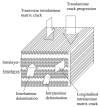A Review on Synthetic Fibers for Polymer Matrix Composites: Performance, Failure Modes and Applications
- PMID: 35888257
- PMCID: PMC9321205
- DOI: 10.3390/ma15144790
A Review on Synthetic Fibers for Polymer Matrix Composites: Performance, Failure Modes and Applications
Abstract
In the last decade, synthetic fiber, as a reinforcing specialist, has been mainly used in polymer matrix composites (PMC's) to provide lightweight materials with improved stiffness, modulus, and strength. The significant feature of PMC's is their reinforcement. The main role of the reinforcement is to withstand the load applied to the composite. However, in order to fulfill its purpose, the reinforcements must meet some basic criteria such as: being compatible with the matrix, making chemical or adhesion bonds with the matrix, having properties superior to the matrix, presenting the optimal orientation in composite and, also, having a suitable shape. The current review reveals a detailed study of the current progress of synthetic fibers in a variety of reinforced composites. The main properties, failure modes, and applications of composites based on synthetic fibers are detailed both according to the mentioned criteria and according to their types (organic or inorganic fibers). In addition, the choice of classifications, applications, and properties of synthetic fibers is largely based on their physical and mechanical characteristics, as well as on the synthesis process. Finally, some future research directions and challenges are highlighted.
Keywords: FRP composites; applications; failure modes; properties; synthetic fibers.
Conflict of interest statement
The authors declare no conflict of interest.
Figures






















References
-
- Andrzejewski J., Gapiński B., Islam A., Szostak M. The Influence of the Hybridization Process on the Mechanical and Thermal Properties of Polyoxymethylene (POM) Composites with the Use of a Novel Sustainable Reinforcing System Based on Biocarbon and Basalt Fiber (BC/BF) Materials. 2020;13:3496. doi: 10.3390/ma13163496. - DOI - PMC - PubMed
Publication types
LinkOut - more resources
Full Text Sources
Miscellaneous

